
Tamarind is a leguminous tree bearing edible fruit that is indigenous to tropical Africa and naturalized in Asia. The genus Tamarindus is monotypic, meaning that it contains only this species. It belongs to the family Fabaceae.

Santalum is a genus of woody flowering plants in the Santalaceae family, the best known and commercially valuable of which is the Indian sandalwood tree, S. album. Members of the genus are trees or shrubs. Most are root parasites which photosynthesize their own food, but tap the roots of other species for water and inorganic nutrients. Several species, most notably S. album, produce highly aromatic wood, used for scents and perfumes and for herbal medicine. About 25 known species range across the Indomalayan, Australasian, and Oceanian realms, from India through Malesia to the Pacific Islands, as far as Hawaiʻi and the Juan Fernández Islands off the coast of South America.

The tamarillo is a small tree or shrub in the flowering plant family Solanaceae. It is best known as the species that bears the tamarillo, an egg-shaped edible fruit. It is also known as the tree tomato, tomate de árbol, tomate andino, tomate serrano, blood fruit, tomate de yuca, tomate de españa, sachatomate, berenjena, chilto and tamamoro in South America, tyamtar, rambheda or rukh tamatar in Nepal, and terong Belanda in Indonesia. It is popular globally, especially in Peru, Colombia, New Zealand, Ecuador, Nepal, Rwanda, Burundi, Australia, Bhutan and the United States.

Lycium barbarum is a shrub native to China, with present-day range across Asia and southeast Europe. It is one of two species of boxthorn in the family Solanaceae from which the goji berry or wolfberry is harvested, the other being Lycium chinense.

Santalum acuminatum, the desert quandong, is a hemiparasitic plant in the sandalwood family, Santalaceae, which is widely dispersed throughout the central deserts and southern areas of Australia. The species, especially its edible fruit, is also commonly referred to as quandong or native peach. The use of the fruit as an exotic flavouring, one of the best known bush tucker, has led to the attempted domestication of the species.

Persicaria hydropiper, also known as water pepper, marshpepper knotweed, arse smart or tade, is a plant of the family Polygonaceae. A widespread species, Persicaria hydropiper is found in Australia, New Zealand, temperate Asia, Europe and North America. The plant grows in damp places and shallow water. Cultivated varieties are eaten in East Asia for their pungent flavor.
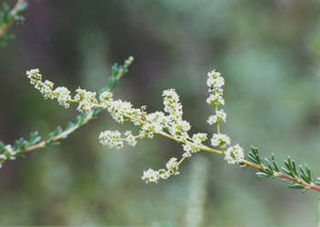
Adenostoma fasciculatum, commonly known as chamise or greasewood, is a flowering plant native to California and Baja California. This shrub is one of the most widespread plants of the California chaparral ecoregion. Chamise produces a specialized lignotuber underground and at the base of the stem, known as a burl, that allow it to resprout after fire has off burned its stems. It is noted for its greasy, resinous foliage, and its status as one of California's most iconic chaparral shrubs.

Santalum album, or Indian sandalwood, is a small tropical tree, and the traditional source of sandalwood oil. It is native to southern India and Southeast Asia. It is considered sacred in some religions like Hinduism, and some cultures place great significance on its fragrant qualities. However, the high value of the species has caused over-exploitation, to the point where the wild population is vulnerable to extinction. Indian sandalwood still commands high prices for its essential oil owing to its high alpha santalol content, but due to lack of sizable trees it is no longer used for fine woodworking as before. The plant is long-lived, but harvest is only viable after many years.

Citrus australis, the Dooja, round lime, Australian lime or Australian round lime, is a large shrub or small tree producing an edible fruit. It grows in forest margins in the Beenleigh area and northwards, in Queensland, Australia.

Myoporum sandwicense, commonly known as naio, bastard sandalwood or false sandalwood is a species of flowering plant in the figwort family, Scrophulariaceae. It is a tree or shrub highly variable in its form, the size and shape of its leaves, in the number of flowers in a group and in the shape of its fruit. It is endemic to Hawaiʻi.
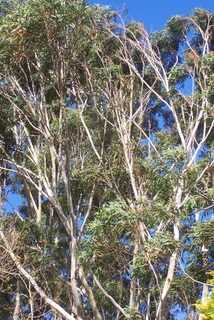
Eucalyptus pilularis, commonly known as blackbutt, is a species of medium-sized to tall tree that is endemic to eastern Australia. It has rough, finely fibrous greyish bark on the lower half of the trunk, smooth white, grey or cream-coloured bark above, lance-shaped to curved adult leaves, flower buds in groups of between seven and fifteen, white flowers and hemispherical or shortened spherical fruit.

Stenocarpus salignus, known as the scrub beefwood is an Australian rainforest tree in the family Proteaceae. Found in warmer rainforests on the coast and ranges. It is often found in warm temperate rainforest on poorer sedimentary soils, or on volcanic soils above 750 metres above sea level. It was originally described by the botanist Robert Brown in 1810.

Cryptocarya laevigata, known as the glossy laurel or red-fruited laurel, is a rainforest plant, which ranges from Malesia and New Guinea to eastern Australia. In Australia it grows in the rainforest understorey on fertile soils, from the Richmond River, New South Wales to Cairns in tropical Queensland, where it is often seen in association with the White Booyong.

Elattostachys nervosa, known as the green tamarind or beetroot tree is a common rainforest tree of eastern Australia. Found in all types of rainforest, growing from Paterson, New South Wales in the south to Gympie in south east Queensland. The name Elattostachys refers to "little spikes", a flower feature of other plants in this genus. Nervosa refers to the prominent leaf venation. Beetroot Tree refers to the beetroot red leaves of the new growth.
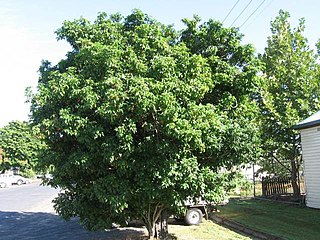
Harpullia pendula, known as the tulipwood or tulip lancewood is a small to medium-sized rainforest tree from Australia. The tree's small size, pleasant form and attractive fruit ensures the popularity of this ornamental tree. The range of natural distribution is from the Bellinger River in northern New South Wales to Coen in tropical Queensland. Tulipwood occurs in various types of rainforest, by streams or dry rainforests on basaltic or alluvial soils. In tropical and sub tropical rainforest. Often seen as a street tree, such as at St Ives, New South Wales.

Petalostigma triloculare, known as the long-leaved bitter bark is a rainforest tree of eastern Australia. It occurs in the drier rainforests, often on sandy soil derived from granite or sandstone, and is sometimes seen on old sand dunes.
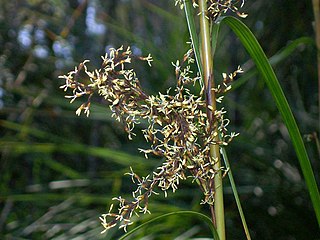
Gahnia melanocarpa, known as the black fruit saw-sedge, is a tussock forming perennial plant in eastern Australia. Often found in the wetter forests or in rainforest margins, it is common on the coast but also seen in the tablelands.
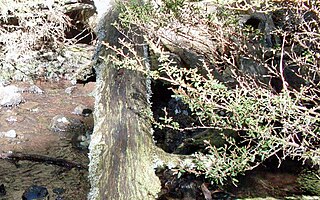
Leptospermum polygalifolium subsp. montanum known as the mountain tea tree or tantoon is a shrub or small tree found in eastern Australia. The original specimen was collected in 1912 near Yarrowitch. This plant is a sub-species of the Tantoon of the Myrtle family. It resembles other plants commonly referred to as "tea trees" or "paperbarks". The sub-species term montanum refers to its habitat of high altitudes. Polygalifolium is derived from Latin, referring to the resemblance of the leaves to certain members of the Polygala.

Persoonia terminalis, also known as the Torrington geebung, is a shrub belonging to the family Proteaceae, and native to northern New South Wales and southern Queensland in eastern Australia. Reported as a subspecies of Persoonia nutans in 1981, it was described as a species by Lawrie Johnson and his colleague Peter Weston in 1991.
Ximenynic acid is trans-11-octadecen-9-ynoic acid, a long-chain acetylenic fatty acid.



















